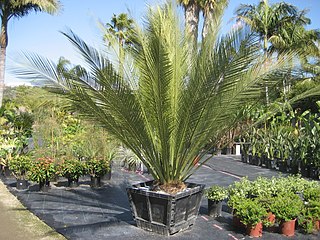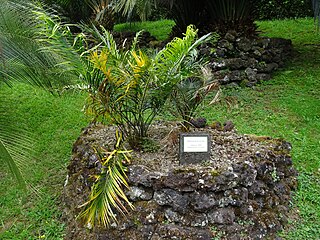
Cycads are seed plants that typically have a stout and woody (ligneous) trunk with a crown of large, hard, stiff, evergreen and (usually) pinnate leaves. The species are dioecious, that is, individual plants of a species are either male or female. Cycads vary in size from having trunks only a few centimeters to several meters tall. They typically grow very slowly and live very long. Because of their superficial resemblance, they are sometimes mistaken for palms or ferns, but they are not closely related to either group.

Macrozamia communis is an Australian cycad found on the east coast of New South Wales. The common name for the species is burrawang, a word derived from the Daruk Australian Aboriginal language; this name is also often applied to other species of Macrozamia.

Macrozamia moorei is a cycad in the family Zamiaceae, native to Queensland (Australia).
Cycas chamaoensis is named after the only known habitat of this species, on and near Khao Chamao mountain in Khao Chamao District, Thailand. Stems are arborescent, either erect or decumbent. Leaves numerous, exceeding 60 per crown, 1.2-2.5 meters in length, ending in terminal spine. Petiole 30–60 cm, glabrous and partially spiny. Leaflets in 85-155 pairs, and lanceolate, glabrous and angled forward at 60-70 degrees.

Wodyetia bifurcata, the foxtail palm, is a species of palm in the family Arecaceae, native to Queensland, Australia. It is the sole species in the genus Wodyetia.

Ceratozamia microstrobila is a species of plant in the family Zamiaceae.

Macrozamia concinna is a part of the plant family, Zamiaceae. It originates from a division of Cycadophyta which encompasses the complete species of cycads. M. concinna is primarily habituated in New South Wales, Australia and maintains a distinct appearance allowing it to be easily identifiable from other cycads. M. concinna also implements a unique method of reproduction to fertilise its offsprings, as opposed to the common method of wind pollination. This difference in reproduction mechanisms has survived throughout the ages of prehistoric cycad species and M. concinna continues to procreate with it.

Macrozamia diplomera is a species of cycad in the family Zamiaceae. It is endemic to New South Wales, Australia.

Macrozamia fraseri is a species of plant in the family Zamiaceae. It is endemic to the south west of Western Australia, and restricted largely to the sandy soils of the Swan Coastal Plain and Geraldton Sandplains. The range of Macrozamia fraseri overlaps that of Macrozamia riedlei. The Noongar peoples know the plant as djiridji.

Macrozamia glaucophylla is a species of cycad from the genus Macrozamia and the family Zamiaceae. Endemic to New South Wales, Australia, this species has features that resembles palms, although both species are taxonomically quite different. The current population trend of Macrozamia glaucophylla is stable with 2,500 to 10,000 mature individuals. The species are found in several habitats including forest and savanna. Ecologically, Macrozamia glaucophylla lives in terrestrial system, a land-based community of organisms where the biotic and abiotic components interact in the given area.

Macrozamia heteromera is a species of cycad in the family Zamiaceae initially discovered by Charles Moore in 1858 and is endemic to New South Wales, Australia. It can be found in the north-western region of New South Wales within the Warrumbungle mountains and further south west towards the Coonabarabran district. It is a low trunked cycad usually at a height below 1 metre and can be found in dry sclerophyll woodlands. M. heteromera can be distinguished from the rest of the Macrozamia genus by its mid-green, narrow, usually divided pinnae and divided seedling pinnae. It is a plant that has toxic seeds and leaves, a characteristic common to cycads. However, after proper preparation and procedure, the seeds are fine for consumption.

Macrozamia johnsonii is a species of cycad in the family Zamiaceae. It is endemic to New South Wales, Australia.

Macrozamia lucida is a species of plant in the family Zamiaceae. It is endemic to Australia.

Macrozamia macdonnellii, common name MacDonnell Ranges Cycad, is a species of plant in the family Zamiaceae. It is endemic to the Northern Territory, Australia.

Macrozamia miquelii, is a species of cycad in the plant family Zamiaceae. It is endemic to Queensland and New South Wales in Eastern Australia. Located within sclerophyll forests dominated by eucalyptus trees, the cycad grows on nutrient-poor soils. It is recognised within the Zamiaceae family for its, medium height at 1 m, intermediate size of male and female cones and lighter green leaves compared to other cycads within the plant family of Zamiaceae. The seeds have an orange red sarcotesta which attracts fauna consumption, allowing a mutualistic seed dispersal for the cycad. These seeds are also edible for human consumption if prepared correctly to remove the toxins.

Macrozamia mountperriensis is a species of plant in the family Zamiaceae endemic to the area around Mount Perry in Queensland; however, it is not considered threatened due to its large population in the area. The species was discovered by colonial botanists including Frederick Manson Bailey and James Keys in the late 1800s. All members of the Zamiaceae family are considered to be poisonous.

Macrozamia riedlei, commonly known as a zamia or zamia palm, is a species of cycad in the plant family Zamiaceae. It is endemic to southwest Australia and often occurs in jarrah forests. It may only attain a height of half a metre or form an above trunk up to two metres with long arching fronds of a similar length. The giant cones amidst the crown of palm-like fronds contain edible seeds surrounded by red sarcotesta. The seeds are consumed by birds and animals, and can be a favoured part of the human diet when prepared correctly. M. riedlei benefits from a close association with bacteria that fix nitrogen, which also produce substances found throughout the plant that are toxic to some animals when consumed. The species is cultivated for ornamental use in urban and domestic environments.

Macrozamia spiralis is a species of cycad in the family Zamiaceae. It is endemic to New South Wales in eastern Australia, where it is found in sclerophyll forest on low-nutrient soils. Plants generally lack a trunk and have 2–12 leaves that range up to 100 cm (40 in) in length.

Encephalartos ghellinckii Lem. or Drakensberg cycad is endemic to South Africa, and is one of about 70 species found in sub-Saharan Africa. Strongly associated with the Natal Drakensberg, this 3m tall evergreen species is found from the foothills to fairly high altitudes, growing on stream banks, steep grassy slopes and sandstone outcrops. Its preferred habitat lying within grassveld, it has developed resistance to veldfires, and also the intense cold brought on by snow and frost.
Macrozamia machinii is a species of cycad in the family Zamiaceae endemic to Queensland, Australia. It is found near Inglewood in the Darling Downs area.




















